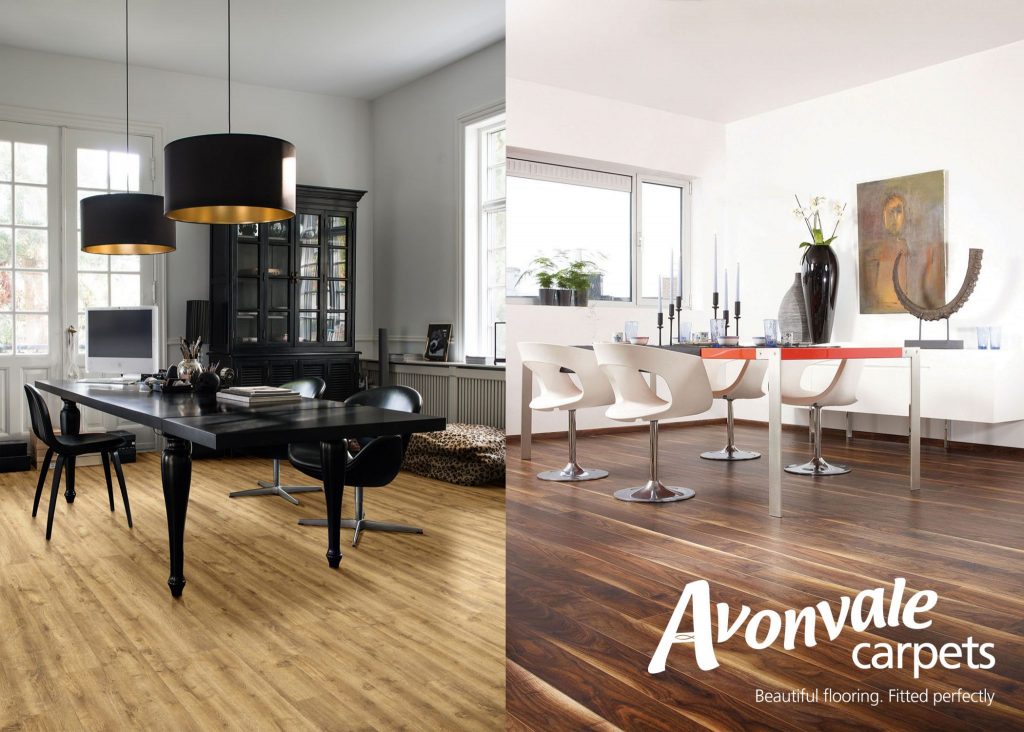For customers looking for stylish, high-quality hard flooring that’s more affordable than real wood, stone or ceramic, there’s a clear choice between luxury vinyl tiles (LVT) or laminate planks. Yes, they appear to do a very similar job, but how do they actually compare?
As an independent retailer that offers both LVT and laminate flooring, we’re often asked the question. And as you’d expect there’s similarities and differences between the two, and pros and cons with each. Having a well-rounded insight will help you make the right choice.
Material
LVT is effectively made from multiple layers of PVC, whereas laminate is composed of high-density fibreboards, made from recycled wood pulp compressed under high pressure. This makes laminate flooring a more environmentally friendly choice, since LVT is not biodegradable.
To achieve their authentic wooden plank, natural stone or ceramic tile appearance, both types of flooring have a high-resolution printed photographic layer, in each case protected by a very tough wear layer on top. In both cases, these layers can also be textured for added authenticity.
Due to their synthetic material compositions, both types of flooring will quite naturally feel a little plastic-like to the touch. Laminate is generally more shiny in appearance, and LVT is normally quieter underfoot.
Designs
Although both types of flooring are these days made to closely imitate all kinds of different natural materials, there is generally a greater choice of designs and colours with LVT than there is with laminate. While laminate still majors on recreating the look of hardwood flooring, LVT designs include hardwood, stone, concrete, marble and even intricate patterned tile effects.
Durability
Since both LVT and laminate floors have a tough urethane wear layer on top, they are both resistant to scratches, bumps and staining, and are certainly a good durable choice in high-traffic areas of the home. Generally speaking LVT is the tougher of the two dies to its thickness and flex.
This doesn’t mean that they’re immune to damage though. Both can be scratched, dented or stained if you try hard enough, a hot ember is not good for either, and prolonged exposure to direct sunlight can cause fading. The room environment and usage always needs to be considered.
Water resistance
Here the difference between LVT and laminate is greatest. Being made from PVC material, LVT really is 100% waterproof. Laminate on the other hand has a wooden fibreboard core and so click-together edges can be damaged by water if spillages aren’t mopped up quickly. That said, more water-resilient laminate floors are gradually becoming more available as well.
Comfort
Compared to cold natural stone or ceramic tile floors, LVT and laminate floors will always feel warmer underfoot. LVT is the warmer and softer of the two, and with the addition of an underlay it can feel warmer still. As for laminate, the thicker it is the better insulated will be the floor. LVT’s sound insulation properties in particular can also bring enhanced sound-proofing and better room acoustics. While product-specific, both LVT and laminate flooring solutions can also offer a high level of slip resistance as well.
Underfloor heating?
And although LVT and laminate are not quite as efficient as stone or tile when used with underfloor heating (UFH), both are perfectly adequate. As each type of flooring will typically withstand floor temperatures of up to 27ºC, UFH systems can be easily specified to suit the needs of the room.
Cleaning
As you’d expect from any type of hard floor, cleaning is comparatively easy. Whether it’s laminate or LVT, through occasional sweeping or vacuuming, wiping up any spillages and an occasional damp mopping, your flooring will retain its good looks for years to come.
Installation
Laminate floors are click-together and laid on top of an underlay to create a ‘floating-floor’. As such, they don’t need to be glued or nailed. While some LVT flooring is now being offered with a floating-floor option, it is traditionally fully glued down to avoid any moisture getting between the planks. This can make LVT a more stable solution overall.
Cost
Taking into account the cost of both the flooring and its installation, there’s actually very little difference between LVT and laminate flooring for the more standard designs and colours. For something more unique or luxurious, LVT can be more expensive. Both offer a highly durable, attractive and more affordable alternative to natural wood, stone or ceramic floors.
At Avonvale Carpets in Bath we provide our customers with what we consider to be a great choice of LVT and laminate flooring options. In LVT we offer product ranges from Invictus, Furlong, Universal, Victoria Design and Westex, while in laminate we offer Furlong and Xylo ranges.
Whether it’s laminate or LVT you’re considering, just pop into the shop and take a look. It beats browsing on the internet 😉

